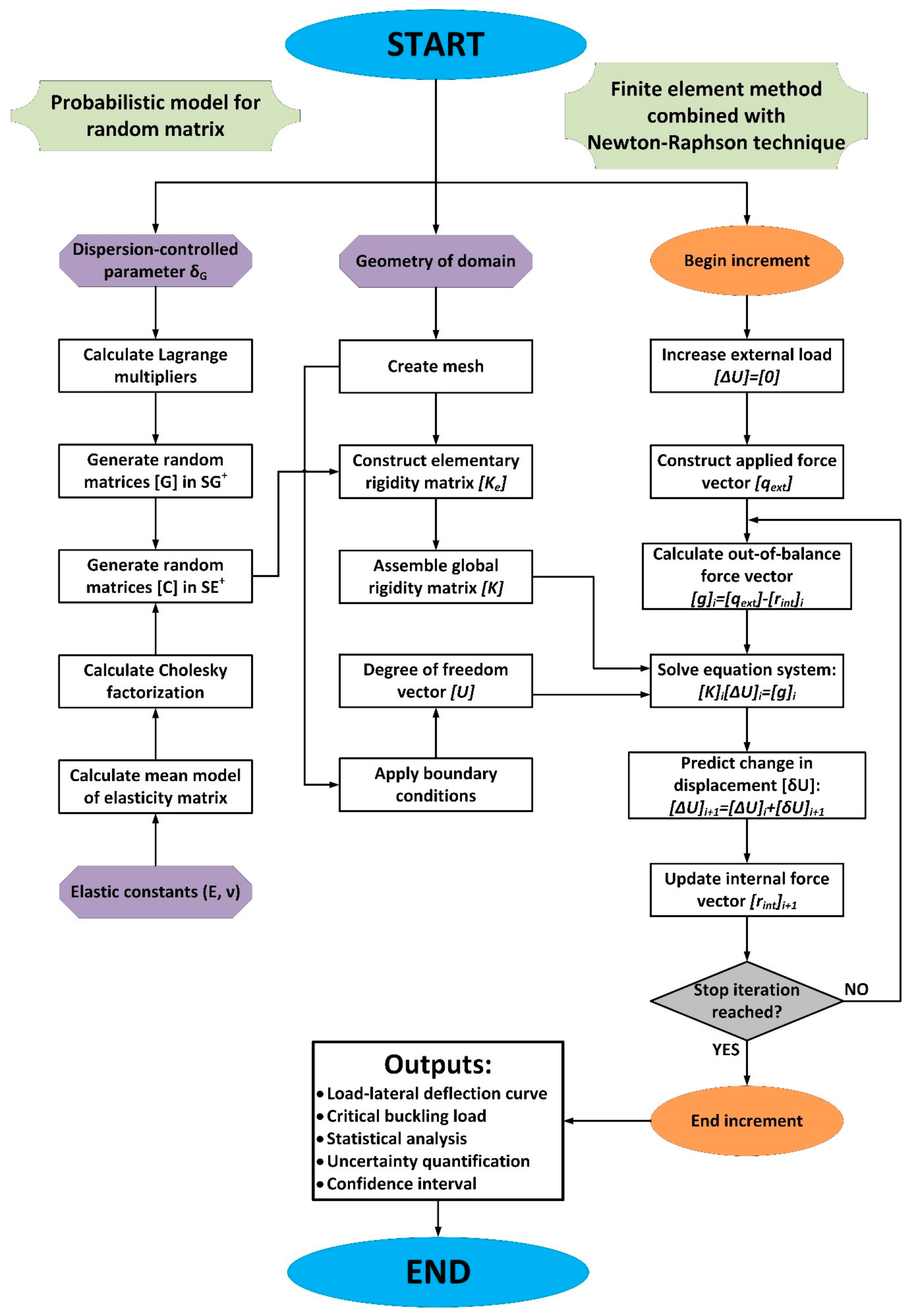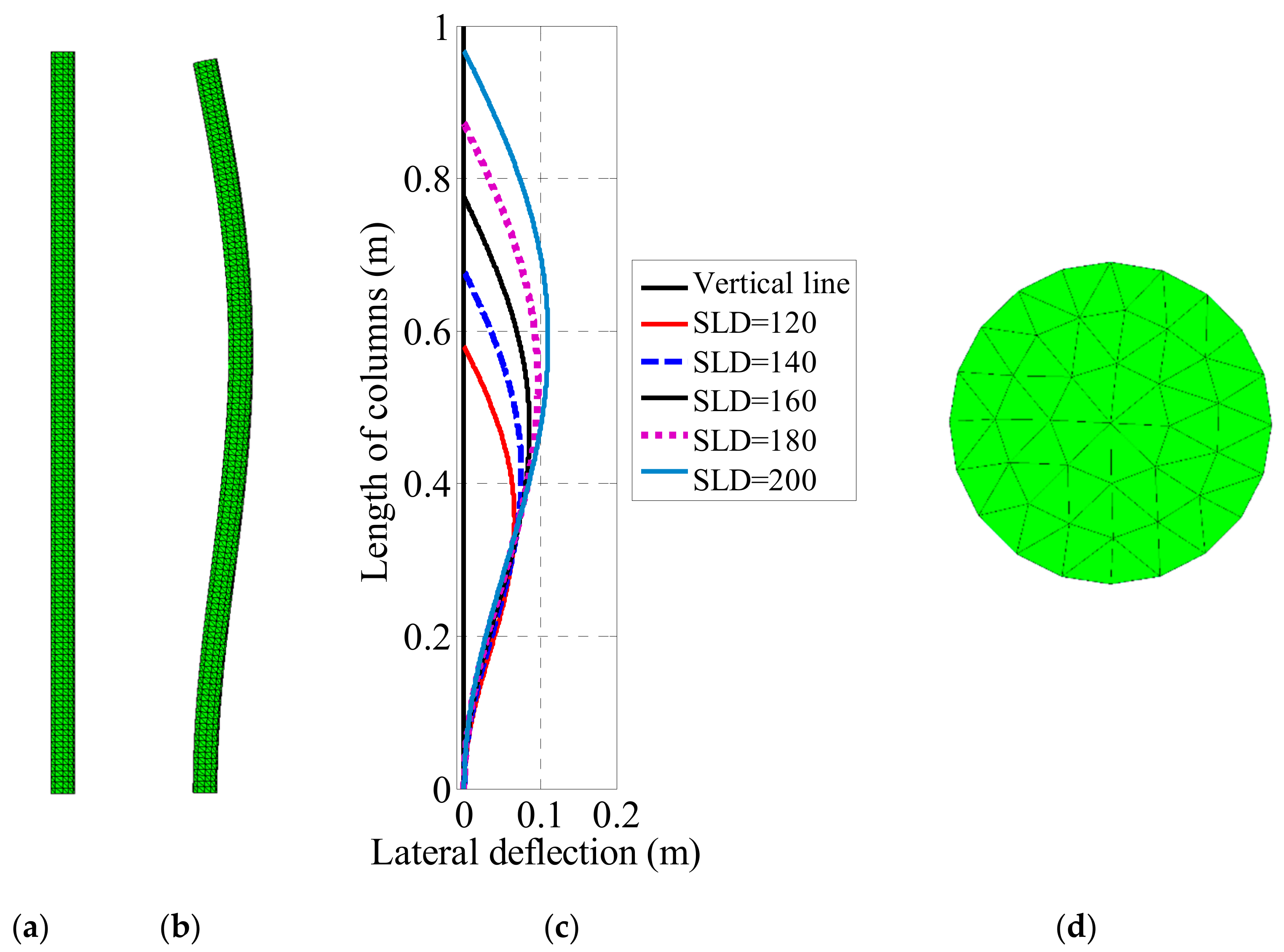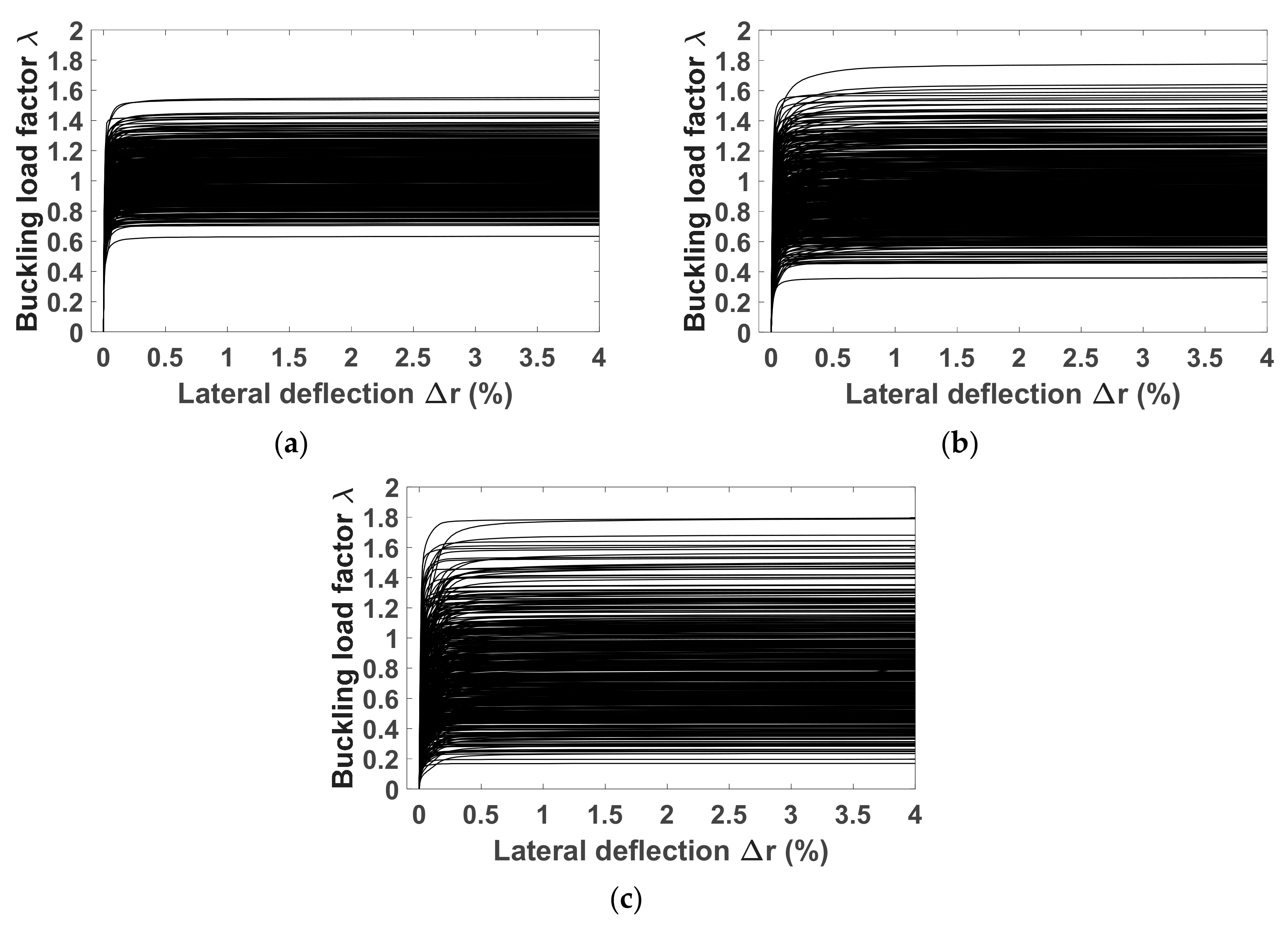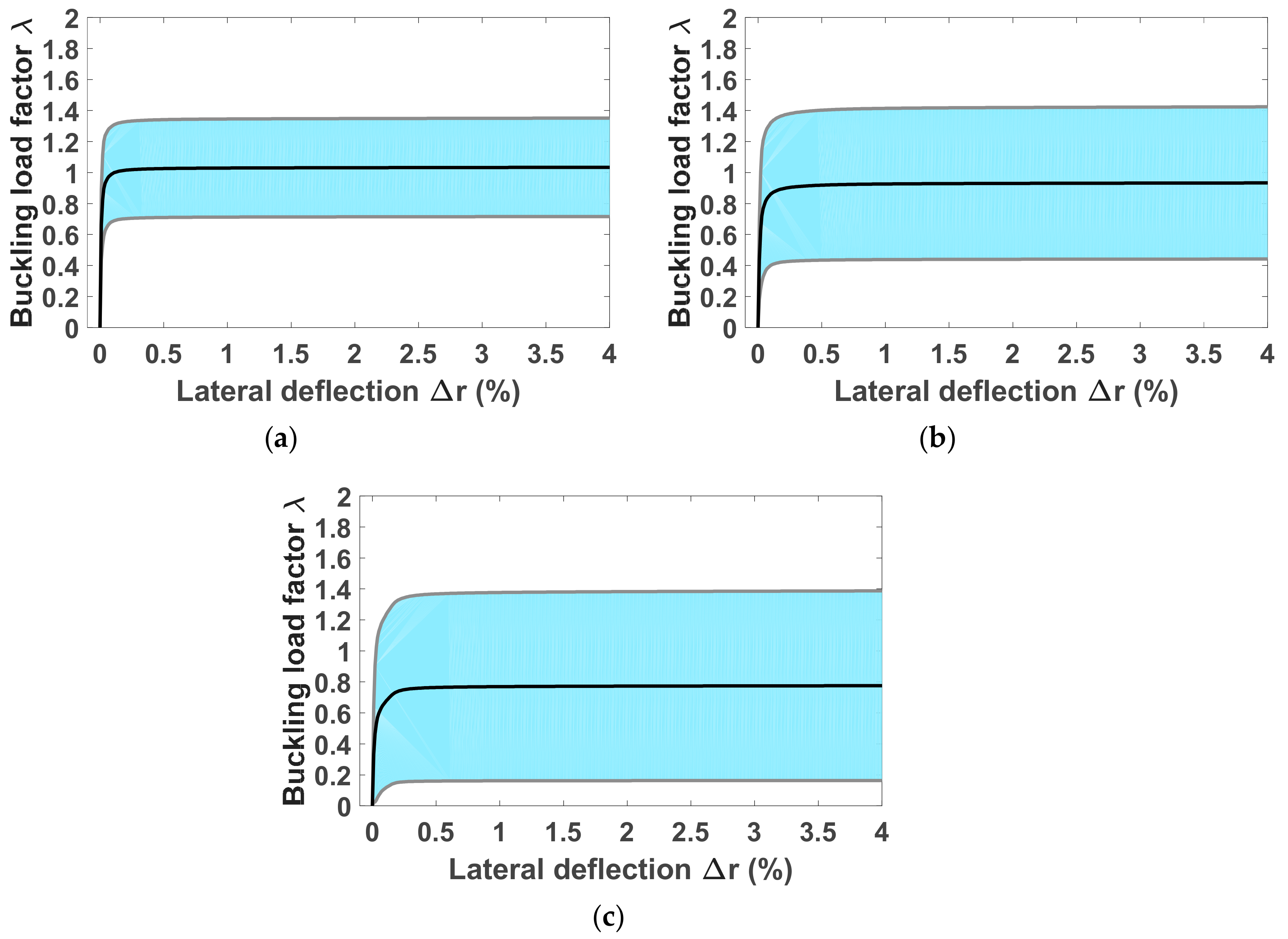Quantification of Uncertainties on the Critical Buckling Load of Columns under Axial Compression with Uncertain Random Materials
Abstract
:1. Introduction
2. Materials and Methods
2.1. Description of the Considered Column and Its Material Properties
2.2. Probabilistic Model for Random Matrix
- Random matrix [C] in ensemble SE+ is positive-definite almost surely with values in ;
- Mean value of [C] is the 6 × 6 given and equal to :where denotes the mathematical expectation operator.
- Inverse of random matrix [C] is almost-surely a second-order random variable:
2.3. Finite Element Formulation
2.4. Newton-Raphson Technique
2.5. Monte Carlo Method
3. Methodology for Modeling
4. Results and Discussion
4.1. Validation of Numerical Tool
4.2. Uncertainty Quantification
4.2.1. Parameters of the Probabilistic Model for Material Uncertainties in Finite Displacement
4.2.2. Uncertainty Quantification
5. Conclusions
Author Contributions
Funding
Conflicts of Interest
References
- Ma, T.-Y.; Liu, X.; Hu, Y.-F.; Chung, K.-F.; Li, G.-Q. Structural behaviour of slender columns of high strength S690 steel welded H-sections under compression. Eng. Struct. 2018, 157, 75–85. [Google Scholar] [CrossRef]
- Yu, X.; Deng, H.; Zhang, D.; Cui, L. Buckling behavior of 420 MPa HSSY columns: Test investigation and design approach. Eng. Struct. 2017, 148, 793–812. [Google Scholar] [CrossRef]
- Kim, D.-K.; Lee, C.-H.; Han, K.-H.; Kim, J.-H.; Lee, S.-E.; Sim, H.-B. Strength and residual stress evaluation of stub columns fabricated from 800MPa high-strength steel. J. Constr. Steel Res. 2014, 102, 111–120. [Google Scholar] [CrossRef]
- Yang, B.; Shen, L.; Kang, S.-B.; Elchalakani, M.; Nie, S.-D. Load bearing capacity of welded Q460GJ steel H-columns under eccentric compression. J. Constr. Steel Res. 2018, 143, 320–330. [Google Scholar] [CrossRef]
- Shi, G.; Jiang, X.; Zhou, W.; Chan, T.-M.; Zhang, Y. Experimental study on column buckling of 420MPa high strength steel welded circular tubes. J. Constr. Steel Res. 2014, 100, 71–81. [Google Scholar] [CrossRef]
- Ban, H.; Shi, G.; Shi, Y.; Wang, Y. Overall buckling behavior of 460 MPa high strength steel columns: Experimental investigation and design method. J. Constr. Steel Res. 2012, 74, 140–150. [Google Scholar] [CrossRef]
- Cao, X.; Xu, Y.; Kong, Z.; Shen, H.; Zhong, W. Residual stress of 800 MPa high strength steel welded T section: Experimental study. J. Constr. Steel Res. 2017, 131, 30–37. [Google Scholar] [CrossRef]
- Cao, K.; Guo, Y.-J.; Zeng, D.-W. Buckling behavior of large-section and 420 MPa high-strength angle steel columns. J. Constr. Steel Res. 2015, 111, 11–20. [Google Scholar] [CrossRef]
- An, Y.F.; Han, L.H. Behaviour of concrete-encased CFST columns under combined compression and bending. J. Constr. Steel Res. 2014, 101, 314–330. [Google Scholar] [CrossRef]
- Falsone, G.; Lombardo, M. Stochastic representation of the mechanical properties of irregular masonry structures. Inter. J. Solids Struct. 2007, 44, 8600–8612. [Google Scholar] [CrossRef] [Green Version]
- Shi, G.; Zhou, W.J.; Bai, Y.; Lin, C.C. Local buckling of 460 MPa high strength steel welded section stub columns under axial compression. J. Constr. Steel Res. 2014, 100, 60–70. [Google Scholar] [CrossRef]
- Dao, H.B.; Dao, V.D.; Vu, H.N.; Nguyen, T.P. Nonlinear static and dynamic buckling analysis of imperfect eccentrically stiffened functionally graded circular cylindrical thin shells under axial compression. Inter. J. Mechan. Sci. 2013, 74, 190–200. [Google Scholar]
- Jamaluddin, N.; Lam, D.; Dai, X.H.; Ye, J. An experimental study on elliptical concrete filled columns under axial compression. J. Constr. Steel Res. 2013, 87, 6–16. [Google Scholar] [CrossRef] [Green Version]
- Vu, L.H.; Duc, N.C.; Dong, L.V.; Truong, D.L.; Anh, N.M.T.; Hung, H.Q.; Hue, P.V. Load Rating and Buckling of Circular Concrete-Filled Steel Tube (CFST): Simulation and Experiment. IOP Conf Ser. Mater. Sci. Eng. 2018, 371, 012032. [Google Scholar] [CrossRef]
- Ghasemi, H.; Rafiee, R.; Zhuang, X.; Muthu, J.; Rabczuk, T. Uncertainties propagation in metamodel-based probabilistic optimization of CNT/polymer composite structure using stochastic multi-scale modeling. Comput. Mater. Sci. 2014, 85, 295–305. [Google Scholar] [CrossRef]
- Eurocode 3: Design of Steel Structures: Part 1–12: High Strength Steel; British Standards Institution: London, UK, 2007.
- Specification for Structural Steel Buildings; American Institute of Steel Construction: Chicago, IL, USA, 2010.
- Soize, C. Stochastic Models of Uncertainties in Computational Mechanics; Amer Society of Civil Engineers: Reston, VA, USA, 2012; ISBN 978-0-7844-1223-7. [Google Scholar]
- Ghanem, R.G.; Spanos, P. Stochastic Finite Elements: A Spectral Approach; Springer-Verlag: New York, NY, USA, 1991; ISBN 978-1-4612-7795-8. [Google Scholar]
- Spanos, P.D. Ghanem Roger Stochastic Finite Element Expansion for Random Media. J. Eng. Mechan. 1989, 115, 1035–1053. [Google Scholar] [CrossRef]
- Soize, C. Maximum entropy approach for modeling random uncertainties in transient elastodynamics. J. Acoust. Soc. Am. 2001, 109, 1979–1996. [Google Scholar] [CrossRef]
- Soize, C. A nonparametric model of random uncertainties for reduced matrix models in structural dynamics. Probab. Eng. Mechan. 2000, 15, 277–294. [Google Scholar] [CrossRef] [Green Version]
- Der Kiureghian, A.; Ke, J.-B. The stochastic finite element method in structural reliability. Probab. Eng. Mechan. 1988, 3, 83–91. [Google Scholar] [CrossRef]
- Vu-Bac, N.; Rafiee, R.; Zhuang, X.; Lahmer, T.; Rabczuk, T. Uncertainty quantification for multiscale modeling of polymer nanocomposites with correlated parameters. Compos. Part B Eng. 2015, 68, 446–464. [Google Scholar] [CrossRef]
- Ilyani Akmar, A.B.; Lahmer, T.; Bordas, S.P.A.; Beex, L.A.A.; Rabczuk, T. Uncertainty quantification of dry woven fabrics: A sensitivity analysis on material properties. Compos. Struct. 2014, 116, 1–17. [Google Scholar] [CrossRef]
- Staber, B.; Guilleminot, J.; Soize, C.; Michopoulos, J.; Iliopoulos, A. Stochastic modeling and identification of a hyperelastic constitutive model for laminated composites. Comput. Methods Appl. Mechan. Eng. 2019, 347, 425–444. [Google Scholar] [CrossRef] [Green Version]
- Castaldo, P.; Gino, D.; Bertagnoli, G.; Mancini, G. Partial safety factor for resistance model uncertainties in 2D non-linear finite element analysis of reinforced concrete structures. Eng. Struct. 2018, 176, 746–762. [Google Scholar] [CrossRef]
- Castaldo, P.; Gino, D.; Mancini, G. Safety formats for non-linear finite element analysis of reinforced concrete structures: discussion, comparison and proposals. Eng. Struct. 2019, 193, 136–153. [Google Scholar] [CrossRef]
- Haukaas, T.; Gardoni, P. Model Uncertainty in Finite-Element Analysis: Bayesian Finite Elements. J. Eng. Mechan. 2011, 137, 519–526. [Google Scholar] [CrossRef]
- Most, T. Assessment of structural simulation models by estimating uncertainties due to model selection and model simplification. Comput. Struct. 2011, 89, 1664–1672. [Google Scholar] [CrossRef]
- Ben Ftima Mehdi; Massicotte Bruno Development of a Reliability Framework for the Use of Advanced Nonlinear Finite Elements in the Design of Concrete Structures. J. Struct. Eng. 2012, 138, 1054–1064. [CrossRef]
- Der Kiureghian, A.; Ditlevsen, O. Aleatory or epistemic? Does it matter? Struct. Saf. 2009, 31, 105–112. [Google Scholar] [CrossRef]
- Korkmaz, K.A.; Demir, F.; Tekeli, H. Uncertainty modelling of critical column buckling for reinforced concrete buildings. Sadhana 2011, 36, 267. [Google Scholar] [CrossRef]
- Athmani, A.; Khemis, A.; Hacene Chaouche, A.; Fah Tee, K.; Ferreira, T.M.; Vicente, R. Buckling Uncertainty Analysis for Steel Pipelines Buried in Elastic Soil Using FOSM and MCS Methods. Int. J. Steel Struct. 2019, 19, 381–397. [Google Scholar] [CrossRef]
- Gao, K.; Gao, W.; Wu, B.; Song, C. Nondeterministic dynamic stability assessment of Euler–Bernoulli beams using Chebyshev surrogate model. Appl. Math. Model. 2019, 66, 1–25. [Google Scholar] [CrossRef]
- Pouresmaeeli, S.; Fazelzadeh, S.A. Uncertain Buckling and Sensitivity Analysis of Functionally Graded Carbon Nanotube-Reinforced Composite Beam. Int. J. Appl. Mechan. 2017, 09, 1750071. [Google Scholar] [CrossRef]
- Damanpack, A.R.; Bodaghi, M.; Liao, W.H. Snap buckling of NiTi tubes. Inter. J. Solids Struct. 2018, 146, 29–42. [Google Scholar] [CrossRef]
- Watkins, R.T.; Reedlunn, B.; Daly, S.; Shaw, J.A. Uniaxial, pure bending, and column buckling experiments on superelastic NiTi rods and tubes. Inter. J. Solids Struct. 2018. [Google Scholar] [CrossRef]
- Jiang, D.; Bechle, N.J.; Landis, C.M.; Kyriakides, S. Buckling and recovery of NiTi tubes under axial compression. Inter. J. Solids Struct. 2016, 80, 52–63. [Google Scholar] [CrossRef]
- Ericksen, J.L. Equilibrium of bars. J. Elast. 1975, 5, 191–201. [Google Scholar] [CrossRef]
- Crisfield, M.A.; Remmers, J.J.; Verhoosel, C.V. Nonlinear Finite Element Analysis of Solids and Structures; John Wiley & Sons: Hoboken, NJ, USA, 1997. [Google Scholar]
- DeSalvo, G.J.; Swanson, J.A. ANSYS Engineering Analysis System User’s Manual; Swanson Analysis Systems, Inc.: Houston, PA, USA, 1985. [Google Scholar]
- Smith, M. ABAQUS/Standard User’s Manual, Version 6.9; Dassault Systemes Simulia Corp: Providence, RI, USA, 2009. [Google Scholar]
- Soize, C. Random matrix theory for modeling uncertainties in computational mechanics. Comput. Methods Appl. Mechan. Eng. 2005, 194, 1333–1366. [Google Scholar] [CrossRef] [Green Version]
- Timoshenko, S.P.; Gere, J.M. Theory of Elastic Stability; McGraw-Hill: New York, NY, USA, 1961. [Google Scholar]
- Jones, R.M. Buckling of Bars, Plates, and Shells; Bull Ridge Publishing: Blacksburg, VA, USA, 2007. [Google Scholar]
- Soize, C. Uncertainty Quantification: An Accelerated Course with Advanced Applications in Computational Engineering; Interdisciplinary Applied Mathematics; Springer International Publishing: Berlin, Germany, 2017; ISBN 978-3-319-54338-3. [Google Scholar]
- Ghanem, R.; Higdon, D.; Owhadi, H. Handbook of Uncertainty Quantification; Springer: New York, NY, USA, 2017; ISBN 978-3-319-12384-4. [Google Scholar]
- Batou, A.; Soize, C. Identification of stochastic loads applied to a non-linear dynamical system using an uncertain computational model and experimental responses. Comput. Mechan. 2009, 43, 559–571. [Google Scholar] [CrossRef]
- Batou, A.; Soize, C.; Corus, M. Experimental identification of an uncertain computational dynamical model representing a family of structures. Comput. Struct. 2011, 89, 1440–1448. [Google Scholar] [CrossRef] [Green Version]
- Capillon, R.; Desceliers, C.; Soize, C. Uncertainty quantification in computational linear structural dynamics for viscoelastic composite structures. Comput. Methods Appl. Mechan. Eng. 2016, 305, 154–172. [Google Scholar] [CrossRef] [Green Version]
- Hauseux, P.; Hale, J.S.; Cotin, S.; Bordas, S.P.A. Quantifying the uncertainty in a hyperelastic soft tissue model with stochastic parameters. Appl. Math. Model. 2018, 62, 86–102. [Google Scholar] [CrossRef] [Green Version]
- Staber, B.; Guilleminot, J. A random field model for anisotropic strain energy functions and its application for uncertainty quantification in vascular mechanics. Comput. Methods Appl. Mechan. Eng. 2018, 333, 94–113. [Google Scholar] [CrossRef]
- Staber, B.; Guilleminot, J. Stochastic hyperelastic constitutive laws and identification procedure for soft biological tissues with intrinsic variability. J. Mechan. Behav. Biomed. Mater. 2017, 65, 743–752. [Google Scholar] [CrossRef] [PubMed] [Green Version]
- Sriramula, S.; Chryssanthopoulos, M.K. Quantification of uncertainty modelling in stochastic analysis of FRP composites. Compos. Part A Appl. Sci. Manuf. 2009, 40, 1673–1684. [Google Scholar] [CrossRef]
- Chiachio, M.; Chiachio, J.; Rus, G. Reliability in composites—A selective review and survey of current development. Compos. Part B Eng. 2012, 43, 902–913. [Google Scholar] [CrossRef]
- Le, T.T.; Guilleminot, J.; Soize, C. Stochastic continuum modeling of random interphases from atomistic simulations. Application to a polymer nanocomposite. Comput. Methods Appl. Mechan. Eng. 2016, 303, 430–449. [Google Scholar] [CrossRef] [Green Version]
- Zhou, X.-Y.; Gosling, P.D.; Pearce, C.J.; Kaczmarczyk, Ł.; Ullah, Z. Perturbation-based stochastic multi-scale computational homogenization method for the determination of the effective properties of composite materials with random properties. Comput. Methods Appl. Mechan. Eng. 2016, 300, 84–105. [Google Scholar] [CrossRef]
- Smith, K.A.; Rahn, C.D.; Wang, C.-Y. Model Order Reduction of 1D Diffusion Systems Via Residue Grouping. J. Dyn. Sys. Meas. Control 2008, 130, 011012. [Google Scholar] [CrossRef]
- Ding, C.; Deokar, R.R.; Cui, X.; Li, G.; Cai, Y.; Tamma, K.K. Proper orthogonal decomposition and Monte Carlo based isogeometric stochastic method for material, geometric and force multi-dimensional uncertainties. Comput. Mechan. 2019, 63, 521–533. [Google Scholar] [CrossRef]
- Criel, P.; Reybrouck, N.; Caspeele, R.; Matthys, S. Uncertainty quantification of creep in concrete by Taylor expansion. Eng. Struct. 2017, 153, 334–341. [Google Scholar] [CrossRef]
- Dao, D.V.; Ly, H.-B.; Trinh, S.H.; Le, T.-T.; Pham, B.T. Artificial Intelligence Approaches for Prediction of Compressive Strength of Geopolymer Concrete. Materials 2019, 12, 983. [Google Scholar] [CrossRef] [PubMed]
- Staber, B.; Guilleminot, J. Stochastic modeling of a class of stored energy functions for incompressible hyperelastic materials with uncertainties. C. R. Mécanique 2015, 343, 503–514. [Google Scholar] [CrossRef] [Green Version]
- Khalil, I.; Pratt, Q.; Schmachtenberger, H.; Ghanem, R. Heat Transfer Modeling of Spent Nuclear Fuel Using Uncertainty Quantification and Polynomial Chaos Expansion. J. Heat Transf. 2017, 140, 022001. [Google Scholar] [CrossRef]
- Cunha, A.; Nasser, R.; Sampaio, R.; Lopes, H.; Breitman, K. Uncertainty quantification through the Monte Carlo method in a cloud computing setting. Comput. Phys. Commun. 2014, 185, 1355–1363. [Google Scholar] [CrossRef] [Green Version]
- Robert, C.; Casella, G. Monte Carlo Statistical Methods, 2nd ed.; Springer Texts in Statistics; Springer-Verlag: New York, NY, USA, 2004; ISBN 978-0-387-21239-5. [Google Scholar]
- Le, L.M.; Ly, H.-B.; Pham, B.T.; Le, V.M.; Pham, T.A.; Nguyen, D.-H.; Tran, X.-T.; Le, T.-T. Hybrid Artificial Intelligence Approaches for Predicting Buckling Damage of Steel Columns Under Axial Compression. Materials 2019, 12, 1670. [Google Scholar] [CrossRef] [PubMed]
- Ly, H.-B.; Monteiro, E.; Le, T.-T.; Le, V.M.; Dal, M.; Regnier, G.; Pham, B.T. Prediction and Sensitivity Analysis of Bubble Dissolution Time in 3D Selective Laser Sintering Using Ensemble Decision Trees. Materials 2019, 12, 1544. [Google Scholar] [CrossRef] [PubMed]
- Pham, B.T.; Nguyen, M.D.; Dao, D.V.; Prakash, I.; Ly, H.-B.; Le, T.-T.; Ho, L.S.; Nguyen, K.T.; Ngo, T.Q.; Hoang, V.; et al. Development of artificial intelligence models for the prediction of Compression Coefficient of soil: An application of Monte Carlo sensitivity analysis. Sci. Total Environ. 2019, 679, 172–184. [Google Scholar] [CrossRef]









| Length of Column L (m) | Radius of Circular Cross-Section R (m) | Slenderness of Column SLD | Critical Buckling Load Factor from FEM | Euler’s Critical Buckling Load Factor | Critical Buckling Load from FEM (kN) | Euler’s Critical Buckling Load (kN) |
|---|---|---|---|---|---|---|
| 0.60 | 0.01 | 120 | 1.010 | 1 | 91.339 | 90.434 |
| 0.65 | 0.01 | 130 | 0.962 | 1 | 74.121 | 77.057 |
| 0.70 | 0.01 | 140 | 0.996 | 1 | 66.176 | 66.442 |
| 0.75 | 0.01 | 150 | 1.004 | 1 | 58.109 | 57.878 |
| 0.80 | 0.01 | 160 | 1.012 | 1 | 51.480 | 50.869 |
| 0.85 | 0.01 | 170 | 0.965 | 1 | 43.461 | 45.061 |
| 0.90 | 0.01 | 180 | 1.001 | 1 | 40.233 | 40.193 |
| 0.95 | 0.01 | 190 | 0.973 | 1 | 35.092 | 36.073 |
| 1.00 | 0.01 | 200 | 1.015 | 1 | 33.044 | 32.556 |
| 1.05 | 0.01 | 210 | 0.965 | 1 | 28.493 | 29.529 |
| 1.10 | 0.01 | 220 | 1.012 | 1 | 27.229 | 26.906 |
| 1.15 | 0.01 | 230 | 0.986 | 1 | 24.270 | 24.617 |
| 1.20 | 0.01 | 240 | 1.016 | 1 | 22.970 | 22.608 |
| Level of Fluctuations in the Elasticity Matrix | Mean | Standard Deviation | Coefficient of Variation (%) |
|---|---|---|---|
| 0 | 1 | 0 | 0 |
| 0.3 | 0.995 | 0.154 | 15.477 |
| 0.5 | 0.861 | 0.230 | 26.713 |
| 0.7 | 0.669 | 0.278 | 41.555 |
© 2019 by the authors. Licensee MDPI, Basel, Switzerland. This article is an open access article distributed under the terms and conditions of the Creative Commons Attribution (CC BY) license (http://creativecommons.org/licenses/by/4.0/).
Share and Cite
Ly, H.-B.; Desceliers, C.; Minh Le, L.; Le, T.-T.; Thai Pham, B.; Nguyen-Ngoc, L.; Doan, V.T.; Le, M. Quantification of Uncertainties on the Critical Buckling Load of Columns under Axial Compression with Uncertain Random Materials. Materials 2019, 12, 1828. https://doi.org/10.3390/ma12111828
Ly H-B, Desceliers C, Minh Le L, Le T-T, Thai Pham B, Nguyen-Ngoc L, Doan VT, Le M. Quantification of Uncertainties on the Critical Buckling Load of Columns under Axial Compression with Uncertain Random Materials. Materials. 2019; 12(11):1828. https://doi.org/10.3390/ma12111828
Chicago/Turabian StyleLy, Hai-Bang, Christophe Desceliers, Lu Minh Le, Tien-Thinh Le, Binh Thai Pham, Long Nguyen-Ngoc, Van Thuan Doan, and Minh Le. 2019. "Quantification of Uncertainties on the Critical Buckling Load of Columns under Axial Compression with Uncertain Random Materials" Materials 12, no. 11: 1828. https://doi.org/10.3390/ma12111828







